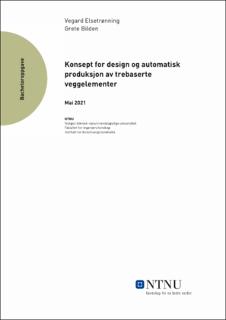| dc.contributor.advisor | Egenes, Jan Steinar | |
| dc.contributor.author | Elsetrønning, Vegard | |
| dc.contributor.author | Bilden, Grete | |
| dc.date.accessioned | 2021-09-24T19:23:40Z | |
| dc.date.available | 2021-09-24T19:23:40Z | |
| dc.date.issued | 2021 | |
| dc.identifier | no.ntnu:inspera:77257390:81861922 | |
| dc.identifier.uri | https://hdl.handle.net/11250/2782293 | |
| dc.description.abstract | En økende trend for etterspørsel av Landheim AS sine veggelementer har ført til at produksjonen ønskes å bli mer effektiv og automatisk. Særlig var det bekymring for at innsetting av vinduer og dører i veggelementet ville gi en flaskehals som forsinket produksjonen. For å løse problemstillingen ble den delt opp i 2 forskningsspørsmål. Første forskningsspørsmålet skulle løse hvordan Landheim kan sette inn vinduer i et veggelement på en mer effektiv måte med redusert tid. Metodene gruppa brukte var besøk hos samarbeidsbedriften Landheim AS sin fabrikk, intervjuer med ressurspersoner på skolen, og konkurrentanalyse. Det andre forskningsspørsmålet ønsker å finne tiltak Landheim kan gjøre for å optimalisere veggelementproduksjonen. Gruppa har brukt 2 konkurrentanalyser, intervjuer av ressurspersoner, og besøk hos Landheim AS for å svare på dette. For å kartlegge nåværende situasjon på fabrikken, ble søk på Østre Toten Kommune sine kartsider gjort for å lage en modell.
Litteratursøk har gått på produksjonsmetoder, hva andre Bachelor- og Masteroppgaver har funnet som kunne bygges på, og element konkurrenter. Anbefalt litteratur har ressursperson Tor Erik Nicolaisen gitt oss, og Oleksandr Semeniuta har gitt oss innsikt i hvordan roboter fungerer og hvilke operasjoner de er i stand til å gjøre.
7 ulike innsettingsmetoder av vindu i veggelement ble resultatene som ble diskutert og analysert videre. I forhold til effektiv veggelementproduksjon, ga konkurrentanalysen resultater i forhold til andre leverandører med eller uten SINTEF sitt godkjenningsmerke. Modellen ble modellert i Tekla Structures, og plan- og snittegninger ble studert i forhold til dagens produksjon og hvordan man kunne effektivisere produksjonslinjene til både etasjeskiller- og veggelement.
Konklusjonen ble å bruke 2 samarbeidende roboter til å håndtere flere operasjoner i tillegg til innsetting av vinduet. Et mindre investeringstungt alternativ ble å montere vinduene i egne elementer, hvor de senere ble montert i resten av bindingsverket. Produksjonslinja besto til slutt av 2 portaler, 4 roboter, en kontrollstasjon, og en pakkemaskin for veggelementene. Etter de 2 portalene og robotene, ble det foreslått å implementere et bord som kunne vippe veggelementet i skrå posisjon slik at innsettingen av vinduet ble enklere. | |
| dc.description.abstract | The growing demand after the wall element Landheim AS is producing, have resulted in Landheim needing the production to become more efficient and more automatic. Particularly there has been a concern for the installation of windows and doors being too time consuming and becoming a bottleneck in the production. To solve this problem, the report was divided into 2 research questions. The first research question tackles how Landheim can insert windows into the wall element in a more efficient way with reduced time. The methods the group used to answer the problem were visits to the factory Landheim AS uses, interviews with professors at the school, and a competitor analysis. The second research question wants to find measures Landheim can make to optimize the wall element production. To answer this, the group used 2 competitor analyzes, interviews with professors, and a visit to Landheim AS. To map the current situation of the factory, a search was made on East Toten home pages to create a model.
The literature has been based on production methods, what other bachelor’s and master’s theses have found of information, and element competitors. Recommended literature has been given to us by Professor Tor Erik Nicolaisen, and Professor Oleksandr Semeniuta has given us insight into how robots work and what kind of operations they are able to perform.
7 different insertion methods of windows in wall elements were the results which were discussed and analyzed further. In relation to efficient wall element production, the competitor analysis gave results in relation to other suppliers with or without SINTEF's approval mark. The model was modeled in Tekla Structures, and floor and sectional drawings were studied in relation to current production and how to streamline the production lines for both the floor and the wall element.
The conclusion was to use 2 cooperating robots to handle several operations in addition to inserting the window. A less investment-intensive alternative was to install the windows in separate elements, where they were later installed in the rest of the timber framing. The production line eventually consisted of 2 portals, 4 robots, a control station, and a packaging machine for the wall elements. After the 2 portals and the robots, it was proposed to implement a table that could tilt the wall element in an inclined position so that inserting the window could become easier. | |
| dc.language | nob | |
| dc.publisher | NTNU | |
| dc.title | Konsept for design og automatisk produksjon av trebaserte veggelementer | |
| dc.type | Bachelor thesis | |
